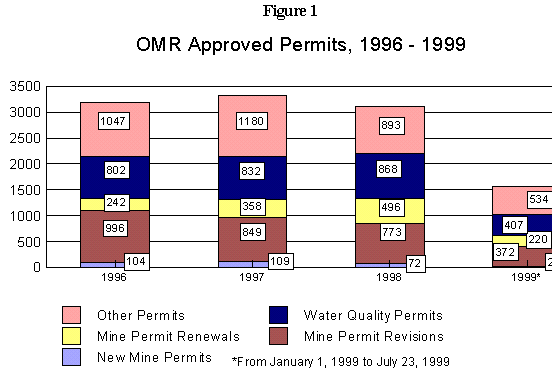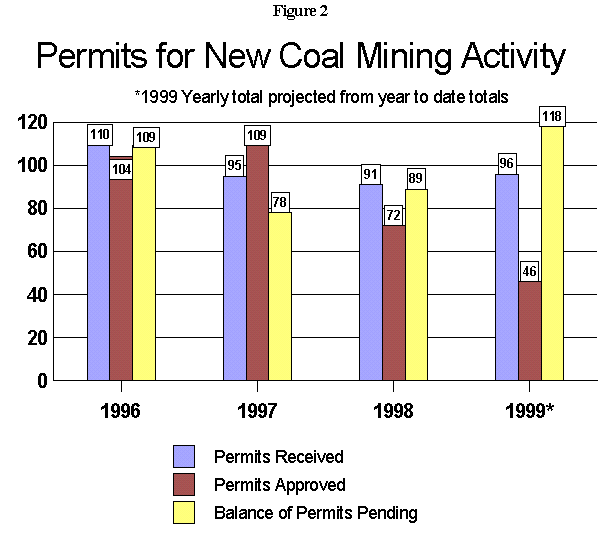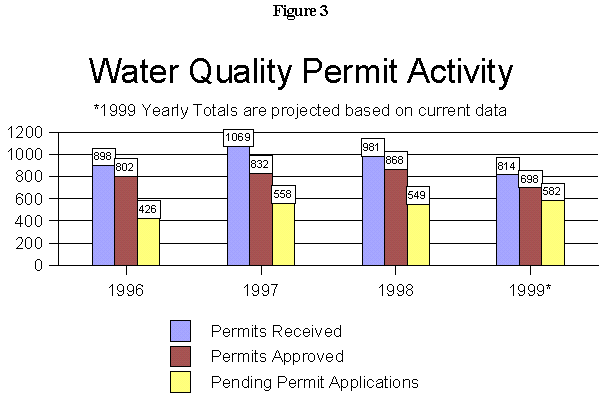
STATE OF WEST VIRGINIA
DIVISION OF ENVIRONMENTAL PROTECTION
Office of Mining and Reclamation
Special Report
OFFICE OF LEGISLATIVE AUDITOR
Performance Evaluation and Research Division
Building 1, Room W-314
State Capitol Complex
CHARLESTON, WEST VIRGINIA 25305
(304) 347-4890
August 1999
Analysis of Approval Time for Coal Mining Permits
The Office of Mining and Reclamation (OMR) within the Division of Environmental Protection (DEP) is the state agency responsible for issuing coal mining permits. OMR oversees all mining activities including reviewing permit applications for surface and underground coal mines, preparation plants, coal loading facilities, haulage ways and coal-related dams. The office also reviews permit applications for non-coal quarry operations (sand, gravel, limestone, etc.).
Each year OMR approves nearly three thousand permitting applications, many of which are for permit renewals or revisions of existing mining operations.(1) Some of these applications are also for water quality permits which a coal company may have to receive that certifies that the mining activity will be in compliance with maintaining the state's water quality standards. A relatively small number of permitting applications (around 100) are approved each year to establish new coal mining operations. Figure 1 shows the yearly totals of permitting applications approved.

Overview of the Permit Process
Coal mining activities that require a permit from OMR generally are within one of three categories: surface mining; underground mining; and other activities. Surface mining represents strip mining activities or the more familiar mountaintop removal. Underground mining involves underground excavations of coal. The Other Activities category includes coal-related activities such as:
ï Haul or access roads;
ï Preparation plants for coal;
ï Coal refuse areas;
ï Coal-related dams or impoundments;
ï Conveyance systems such as slurry lines, conveyor belts, etc.; and,
ï Storage facilities.
These three categories are used to describe not only applications for new coal mining permits, but also revisions to current mining permits.
Since the circumstances surrounding the issuance of new mining permits vary largely from permit to permit and from company to company, there is a large variance in issuance times for these permits. Because of this variance, it is more useful to examine the median time to issue permits for new mine activity than the average time to issue permits. As Table 1 illustrates, the median time to issue permits for new surface mining activities has gradually increased from 232 days (half of the permits being issued in less than 232 days while half of the permits took longer than 232 days) to 323 days between calendar year 1996 and 1999. Table 1 also shows that the minimum time that the OMR issued a surface mine permit has increased from a low of 106 days in 1998 to high of 221 days in 1999. From 1996 to 1998, the median time to issue other mining permits (haul or access roads, preparation plants, coal refuse areas, coal related dams or impoundments, conveyance systems and storage facilities) as well as underground mine permits was gradually decreasing. However, as Table 1 shows, as of 1999 the median time to issue these permits has increased. In the case of underground mine permits, the median time to issue these permits has increased dramatically to the longest time in the last four years. Furthermore, the shortest time to issue an underground permit is higher than in past years, and more than twice the time in 1998.
Table 1
Median Time to Issue Coal Mining Permits for New Operationsï
|
Permit Type |
Calendar Year |
Number of Permits Issued |
Median Time |
High |
Low |
|
Other Mining Activities |
1996 | 11 | 371 Days | 1206 Days | 150 Days |
| 1997 | 15 | 229 Days | 1292 Days | 122 Days | |
| 1998 | 9 | 192 Days | 2379 Days | 141 Days | |
| 1999* | 3 | 246 Days | 546 Days | 204 Days | |
|
Surface Mine |
1996 | 43 | 232 Days | 703 Days | 165 Days |
| 1997 | 44 | 240 Days | 1574 Days | 107 Days | |
| 1998 | 21 | 285 Days | 923 Days | 106 Days | |
| 1999* | 7 | 323 Days | 838 Days | 221 Days | |
|
Underground |
1996 | 44 | 272 Days | 1433 Days | 119 Days |
| 1997 | 37 | 250 Days | 1432 Days | 114 Days | |
| 1998 | 36 | 202 Days | 2324 Days | 65 Days | |
| 1999* | 16 | 347 Days | 1386 Days | 161 Days | |
| * Represents January 1, 1999 through June 30, 1999 | |||||
As the median time to issue permits increases, and the number of permits received stays constant, fewer permits will be issued. As Figure 2 shows, based on an extrapolation of data for the first half of 1999, the OMR is projected to issue the lowest number of coal mining permits in the last four years. As the number of permits issued decreases, Figure 2 also shows that the final number of permits pending at the end of the year will increase.

Delays on Water Quality Permit Issuance
Delays are also being experienced in the issuance of water quality permits, which are called National Pollutant Discharge Elimination System (NPDES) permits, for mine related activities. The NPDES permits certify that a specific activity is in compliance with the state's water quality standards. NPDES permits for coal related activities are processed by the OMR, and are issued by the Office of Water Resources. Figure 3 shows that, like surface mine applications, based on extrapolation of data for the first half of 1999, it is projected that the number of NPDES permits issued this year will be the lowest in the last four years.

Applications for new proposed mining activities represent a small portion of the applications received by the OMR, while permit revisions for existing operations constitute a large portion of the applications received. There are two types of revisions: (1) revisions to the boundaries of an existing permit, and (2) revisions within the boundaries to the actual mine. The median time to issue permits for revisions has seen only a minor increase, and has remained relatively constant over a four year period. It is interesting to note that for Boundary Revisions, the highest time to issue the permit has increased steadily each year, while the highest time to issue permits for Revisions within Boundaries has declined significantly each year. Table 2 shows the median time to issue permits for revisions.
Table 2
Median Time to Approve Revision to Coal Mining Permits
|
Revision Type |
Year |
Number of Permits Issued |
Median Time |
High |
|
Boundary Revision |
1996 | 363 | 62 Days | 785 Days |
| 1997 | 357 | 56 Days | 874 Days | |
| 1998 | 313 | 69 Days | 902 Days | |
| 1999 | 132* | 69 Days | 1146 Days | |
|
Revisions within Boundary |
1996 | 606 | 43 Days | 1464 Days |
| 1997 | 467 | 49 Days | 1532 Days | |
| 1998 | 438 | 63 Days | 525 Days | |
| 1999 | 240* | 62 Days | 717 Days | |
| *January to June 1999 | ||||
Affects of Delays on Permit Backlog
As permit applications pending at the end of the year increases and the number of permit applications received each year stays relatively stable, the OMR will likely see an increase in the permit application backlog. Currently, the OMR has four regional offices. Table 3 shows the current number of total pending permit applications for each regional office. These offices are located at Logan, Welch, Philippi, and Oak Hill. Oak Hill and Logan are the largest of these regional offices. According to the OMR, anything over 300 pending applications for Oak Hill and Logan constitutes a backlog. Welch and Philippi have no established backlog standard, however, since they are not as large of an office as either Oak Hill or Logan, it is implied that if they have more than 300 permits pending, then they also have a backlog. Therefore, based on OMR's criteria for what constitutes a backlog, three of the four regional offices have a backlog of pending permit applications.
| Table 3
Pending Permits by Regional Office | ||
| Office | Permits Pending | Review Not Started |
| Welch | 211 | 17 |
| Oak Hill | 346 | 81 |
| Philippi | 331 | 118 |
| Logan | 387 | 102 |
| Current as of July 23, 1999 | ||
Conclusion
Coal mining permit activity for the first seven months of 1999 reveals that the median time to issue coal mining permits has increased. This increase in median time affects permits for underground mines, surface mines, as well as other mining related permits. In the case of underground mine permits, the median time to issue these permits has increased dramatically to the longest time in the last four years. Although the factors which impact the issuance of mining permits have not affected revisions to permits, it has affected the issuance of water quality permits. It is expected that the number of permits issued this year will be significantly less this year than in previous years. The causes of these delays is uncertain; however, an examination of causes of increased time to issue permits will be the subject of a subsequent report.
1. Many permits must be renewed because they are issued for terms not to exceed five years. Revisions may be to expand the mining boundaries specified within a permit for an active mining operation, or to make changes within the boundaries specified in a permit for an active operation.